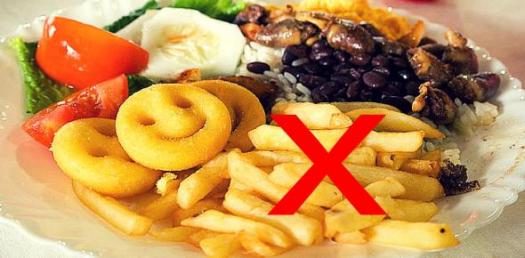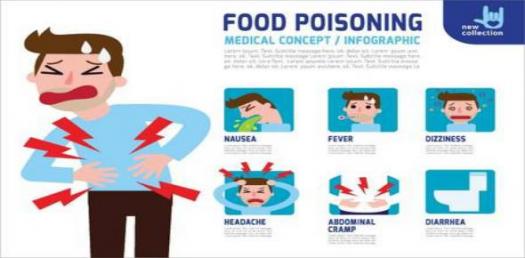Ultimate Trivia Questions On Food Poisoning! Quiz

Food poisoning is global health issue of utmost concern to the World Health Organisation. According to experts, food poisoning occurs when there is contamination of food particle either in the process of preparation or naturally. Do you know the toxins that naturally occur in some food crops? Have some fun by raking this simple quiz!
- 1.
What is the poison present in parsnips?
- A.
Botulinum
- B.
Furocoumarins
- C.
Cyanogenic glycosides
- D.
Lectins
Correct Answer
B. FurocoumarinsExplanation
Furocoumarins are the poison present in parsnips. Furocoumarins are a type of organic compound that can cause photosensitivity and skin reactions when exposed to sunlight. They are naturally occurring in certain plants, including parsnips. Consuming parsnips that contain furocoumarins can lead to skin rashes and blisters when the skin is exposed to sunlight. Therefore, it is important to handle and cook parsnips properly to minimize the risk of furocoumarin poisoning.Rate this question:
-
- 2.
What is the poison present in beans?
- A.
Venom
- B.
Botulinum
- C.
Lectins
- D.
Cyanogenic glycosides
Correct Answer
C. LectinsExplanation
Lectins are proteins found in many plants, including beans. They act as a defense mechanism for the plants, deterring insects and animals from consuming them. While lectins are generally harmless when consumed in small amounts, some people may have an adverse reaction to them. In high concentrations, lectins can cause digestive issues and interfere with nutrient absorption. Therefore, it is important to properly cook and prepare beans to reduce the lectin content and make them safe for consumption.Rate this question:
-
- 3.
Which of these food poisoning symptoms is associated with increased temperature?
- A.
Vomiting
- B.
Fever
- C.
Watery diarrhea
- D.
Nausea
Correct Answer
B. FeverExplanation
Fever is the correct answer because it is a symptom commonly associated with food poisoning. When the body is infected with harmful bacteria or toxins from contaminated food, it often responds by raising its temperature to fight off the infection. This increase in body temperature is known as a fever. Vomiting, watery diarrhea, and nausea can also be symptoms of food poisoning, but they are not specifically associated with an increased temperature.Rate this question:
-
- 4.
What symptom of food poisoning is associated with discomfort in the gastrointestinal system?
- A.
Abdominal pain
- B.
Vomiting
- C.
Fever
- D.
Headache
Correct Answer
A. Abdominal painExplanation
Abdominal pain is a common symptom of food poisoning and is associated with discomfort in the gastrointestinal system. It is often caused by the inflammation or irritation of the stomach and intestines due to the consumption of contaminated food or drink. This pain can range from mild to severe and is typically accompanied by other symptoms such as nausea, diarrhea, and bloating. It is an important symptom to look out for when suspecting food poisoning as it can help in identifying the cause and seeking appropriate medical treatment.Rate this question:
-
- 5.
Which of these is not a common germ that causes food poisoning?
- A.
Salmonella
- B.
Escherichia coli
- C.
Campylobacter.
- D.
Clostridium perfringens.
Correct Answer
B. Escherichia coliExplanation
Escherichia coli, commonly known as E. coli, is not a common germ that causes food poisoning. While it is a type of bacteria that is naturally present in the intestines of humans and animals, certain strains of E. coli can cause illness when ingested through contaminated food or water. However, compared to other bacteria like Salmonella, Campylobacter, and Clostridium perfringens, E. coli is less commonly associated with food poisoning cases. Therefore, it is the correct answer in this context.Rate this question:
-
- 6.
What are the positive and negative features that affect the value of a food product to the consumer called?
- A.
Food poisoning
- B.
Food control
- C.
Food quality
- D.
Food regulation
Correct Answer
C. Food qualityExplanation
Food quality refers to the positive and negative features that affect the value of a food product to the consumer. It encompasses various aspects such as taste, appearance, nutritional value, freshness, and safety. Positive features of food quality include good taste, high nutritional value, and freshness, which increase the value of the product to the consumer. On the other hand, negative features such as contamination, spoilage, or lack of nutritional value can decrease the value of the food product to the consumer. Therefore, food quality is the most appropriate term to describe the positive and negative features that affect the value of a food product to the consumer.Rate this question:
-
- 7.
What are the toxins present in molds called?
- A.
Cyanide
- B.
Furocoumarins
- C.
Lectins
- D.
Mycotoxins
Correct Answer
D. MycotoxinsExplanation
Mycotoxins are the toxins present in molds. These toxic compounds are produced by certain types of fungi and can contaminate food, feed, and other organic materials. Mycotoxins are known to have harmful effects on humans and animals, including causing respiratory problems, allergic reactions, and even cancer. Therefore, it is important to be aware of the presence of mycotoxins and take necessary measures to prevent their exposure.Rate this question:
-
- 8.
Which of these food crops does not contain solanines?
- A.
Tomato
- B.
Eggplant
- C.
Cabbage
- D.
Potatoes
Correct Answer
C. CabbageExplanation
Cabbage does not contain solanines. Solanines are toxic compounds that are naturally found in certain plants, particularly in the nightshade family. Tomato, eggplant, and potatoes all belong to the nightshade family and can contain solanines. However, cabbage is not a nightshade plant and therefore does not contain solanines.Rate this question:
-
- 9.
Which of these is not a plant source of pyrrolizidine alkaloids?
- A.
Zea mays
- B.
Boraginaceae
- C.
Asteraceae
- D.
Fabaceae
Correct Answer
A. Zea maysExplanation
Zea mays, also known as corn, is not a plant source of pyrrolizidine alkaloids. Pyrrolizidine alkaloids are found in certain plant families, such as Boraginaceae, Asteraceae, and Fabaceae. Zea mays belongs to the family Poaceae, which does not produce pyrrolizidine alkaloids.Rate this question:
-
- 10.
Which of these is not a foodborne illness?
- A.
Cholera
- B.
Typhoid
- C.
Seizure
- D.
Dysentery
Correct Answer
C. SeizureExplanation
Seizure is not a foodborne illness. It is a neurological disorder characterized by abnormal electrical activity in the brain. Cholera, Typhoid, and Dysentery are all examples of foodborne illnesses caused by consuming contaminated food or water.Rate this question:
-
Quiz Review Timeline +
Our quizzes are rigorously reviewed, monitored and continuously updated by our expert board to maintain accuracy, relevance, and timeliness.
-
Current Version
-
Mar 19, 2023Quiz Edited by
ProProfs Editorial Team -
Jul 19, 2019Quiz Created by
Gregorynaomi
 Back to top
Back to top












